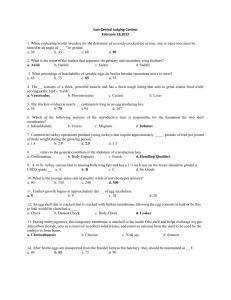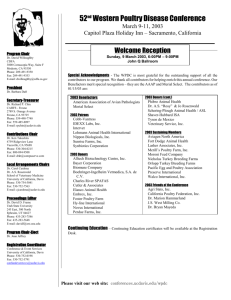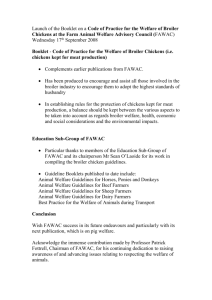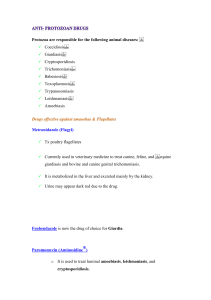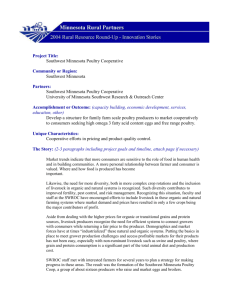A_Annex XV_Draft chapter on AW_and Broiler Production
advertisement
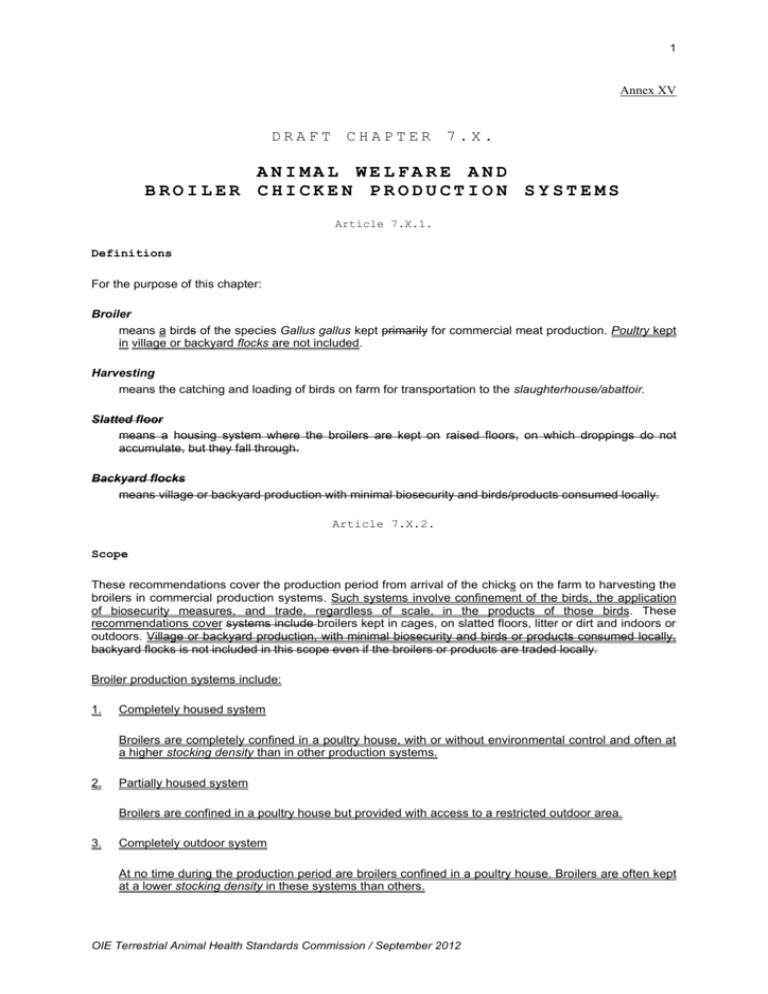
1 Annex XV DRAFT CHAPTER 7.X. ANIMAL WELFARE AND BROILER CHICKEN PRODUCTION SYSTEMS Article 7.X.1. Definitions For the purpose of this chapter: Broiler means a birds of the species Gallus gallus kept primarily for commercial meat production. Poultry kept in village or backyard flocks are not included. Harvesting means the catching and loading of birds on farm for transportation to the slaughterhouse/abattoir. Slatted floor means a housing system where the broilers are kept on raised floors, on which droppings do not accumulate, but they fall through. Backyard flocks means village or backyard production with minimal biosecurity and birds/products consumed locally. Article 7.X.2. Scope These recommendations cover the production period from arrival of the chicks on the farm to harvesting the broilers in commercial production systems. Such systems involve confinement of the birds, the application of biosecurity measures, and trade, regardless of scale, in the products of those birds. These recommendations cover systems include broilers kept in cages, on slatted floors, litter or dirt and indoors or outdoors. Village or backyard production, with minimal biosecurity and birds or products consumed locally, backyard flocks is not included in this scope even if the broilers or products are traded locally. Broiler production systems include: 1. Completely housed system Broilers are completely confined in a poultry house, with or without environmental control and often at a higher stocking density than in other production systems. 2. Partially housed system Broilers are confined in a poultry house but provided with access to a restricted outdoor area. 3. Completely outdoor system At no time during the production period are broilers confined in a poultry house. Broilers are often kept at a lower stocking density in these systems than others. OIE Terrestrial Animal Health Standards Commission / September 2012 2 Annex XV (contd) This chapter should be read in conjunction with Chapters 7.2., 7.3. and 7.4. on the welfare of the broiler during transport to the slaughterhouse/abattoir. Article 7.X.3. Commercial Broiler production systems Commercial Broiler production systems include: 1. Intensive systems Broilers are completely confined in a poultry house, with or without environmental control and usually at a higher stocking density than in other production systems. Broilers may be kept in cages, with (e.g. wire or plastic floor or deep litter floor) or on litter, or slatted floors or a combination 2. Semi-intensive systems Broilers are confined in a poultry house but provided with access to a restricted outdoor area. 3. Extensive systems Broilers are not confined throughout the production period in a poultry house. and are usually kept at a lower stocking densitythan in intensive or semi intensive systems. Article 7.X.4. Criteria or measurables for the welfare of broilers Measurables can be based on the outcomes for the broiler (outcome based criteria) or the design of the system (resource or design based criteria). Outcome based measurables may give a better indication of welfare than resource based measures because they reflect the complex interaction of several variables (e.g. experience and attitude of handlers and disease situation) that may be overlooked when relying on criteria that focus on the design of the system. Some measurables can be measured in the farm setting (e.g. gait, mortality and morbidity rates), while others are best measured at the slaughterhouse/abattoir. For example, at slaughter flocks can be assessed for presence of bruising, broken limbs and injuries. The age of these lesions can help to determine the source (e.g. catching) (Nicol & Scott, 1990). Back scratching, hock and feet foot burns and breast blisters are also easily observed at the slaughterhouse/abattoir. Other conditions such as ascites, leg deformities, dehydration and disease conditions can also be assessed at this point. It is recommended that values for welfare measurables be determined with reference to appropriate national, sectoral or perhaps regional norms for commercial broiler production. The following outcome based measurables are useful indicators of broiler welfare: 1. Mortality (dead, culled) and morbidity Daily, weekly and cumulative mortality (dead or culled) and morbidity rates should be within expected ranges. Any unforeseen increase in the daily mortality or morbidity rate could reflect an animal welfare problem. OIE Terrestrial Animal Health Standards Commission / September 2012 3 Annex XV (contd) 2. Gait Broilers are susceptible to developing a variety of infectious and non-infectious musculoskeletal disorders (see review in Mench, 2004). If severe These disorders may lead to overt lameness, and if less severe to gait abnormalities. Broilers that are lame or have more serious gait abnormalities may have difficulty reaching the food and water, may be trampled by other broilers, and may experience pain. Musculoskeletal problems have many causes, including related to genetics, nutrition, sanitation, lighting, litter quality, and other environmental and management factors (see Mench, 2004; Dawkins et al., 2004). Broilers in commercial flocks should be assessed for gait abnormalities, and corrective actions identified to reduce the incidence of problems in subsequent flocks. There are several gait scoring systems available (Kestin et al., 1992; Garner et al., 2002; Webster et al., 2008; Weeks et al., 2002; Berg and Sanotra, 2003). Regardless of the scoring or assessment system used, broilers that are unable to access feed or water should be humanely euthanized as soon as possible after they have been observed. 3. Contact dermatitis Contact dermatitis affects skin surfaces which that have prolonged contact with litter or other flooring surfaces, including the foot pad, rear surface of the hock and, when severe, the breast area. The conditions are is manifested as blackened skin progressing to erosions and fibrosis on the lower surface of the foot pad, at the back of the hocks, and sometimes in the breast area. If severe, the foot and hock lesions may contribute to lameness and lead to secondary infections. Validated sScoring systems for contact dermatitis have been developed (see Welfare Quality®, 2009). 4. Feather condition Evaluation of the feather condition of broilers provides useful information about aspects of welfare. Plumage dirtiness and naked area are is correlated with both hock burns and lameness for individual birds (Arnould and Colin, 2009). Plumage dirtiness can be assessed as part of on-farm inspections, when the broilers are caught for transport to the slaughterhouse/abattoir and prior to plucking. A scoring system has been developed for this purpose (RSPCA, 2008). 5. Incidence of diseases, metabolic disorders and parasitic infestations Ill-health, regardless of the cause, is a welfare concern, and may be exacerbated by poor environmental or husbandry management. Ascites, sudden death syndrome and respiratory diseases (including infectious bronchitis, avian pneumovirus infection and mycoplasmosis) are of great economic and welfare significance in broilers (SCAHAW, 2000). 6. Normal Behaviour Broiler behaviour can be a sensitive indicator of welfare problems. a) Fear behaviour Fearful broilers show avoidance of humans, and this behaviour is seen in flocks where animal handlers walk through the poultry house quickly when performing their tasks rather than moving more slowly while interacting with the broilers (Cransberg et al., 2000). Fearfulness (e.g. of sudden loud noises) can also lead to the broilers piling on top of, and even suffocating, one another. Fearful broilers may be less productive (Hemsworth et al., 1994). OIE Terrestrial Animal Health Standards Commission / September 2012 4 Annex XV (contd) b) Spatial distribution Changes in the spatial distribution (e.g. huddling) of the birds may indicate thermal discomfort (e.g. broilers will huddle when they are cold) or the existence of areas of wet litter or uneven provision of light, food or water (if broilers are unevenly distributed). c) Panting and wing spreading Panting and wing spreading may indicates heat stress or high levels of ammonia. d) Dust bathing Dust bathing is an intricate body maintenance behaviour performed by many birds, including broilers (Olsson and Keeling, 2005). During a dust bathing bout, broilers work loose material, such as litter, through their feathers. Dust bathing helps to keep the feathers in good condition, which in turns helps to maintain body temperature and protect against skin injury. Reduced dust bathing behaviour in the flock may indicate problems with litter or range quality, such as litter or ground being that is wet or not friable. e) Feeding, drinking and foraging Reduced feeding or drinking behaviour can indicate management problems, including inadequate feeder or drinker space or placement, dietary imbalance, poor water quality, or feed contamination. Feeding and drinking behaviour are often depressed when broilers are ill, and feeding is also reduced during periods of heat stress and increased during cold stress. Foraging is the act of searching for food, typically by walking and pecking or scratching the litter substrate; reduced foraging activity could suggest problems with litter quality or presence of conditions that decrease bird movement (e.g. gait problems). f)7. Abnormal behaviour- Feather pecking and cannibalism Feather pecking is or pulling of the feathers Feather pecking can result in significant feather loss. and may lead to cannibalism. Cannibalism is the tearing of the flesh of another bird, and can result in severe injury or, and even the death of the pecked broiler. These are abnormal behaviours (Mench and Keeling, 2001; Rodenberg and Koene, 2004; Newberry, 2004) have with multi-factorial causes. that are not usually seen in commercial broiler stocks, although they can occur under some circumstances. Feather pecking may sometimes lead to cannibalism or may occur independently; once started, these problems can spread rapidly through the flock. 78. Water and feed consumption Monitoring daily water consumption can be a useful tool to indicate disease and other welfare conditions, taking into consideration ambient temperature, relative humidity, feed consumption and other related factors. Problems with the water supply can result in wet litter, diarrhoea, dermatitis or dehydration. Changes in feed consumption can also indicate unsuitability of feed, the presence of disease or and other welfare problems conditions of the flock as well as suitability of the feed. 89. Performance a) Growth rate - an index that indicates the average daily gain (gr) of weight per average broiler of a flock. OIE Terrestrial Animal Health Standards Commission / September 2012 5 Annex XV (contd) b) Feed conversion - an index that indicates the quantity of feed (kg) that is necessary for a gain of bodyweight of one kilogram of the average broiler of a flock measures the quantity of feed consumed by a flock relative to the total liveweight harvested, expressed as a the weight of feed required to produce one kg of broiler body weight. c) Liveability - an index that indicates the percentage of broilers present at the end of the production period; more commonly this indicator is measured as its opposite,: mortality (see point 1 of Article X.X.4.). 910. Injury rate Broilers are susceptible to a number of injuries, and the rate of these injuries can indicate welfare problems in the flock during production or capture harvesting. Injuries include those due to other broilers (scratches, feather loss or wounding due to feather pecking and cannibalism) and those due to environmental conditions (e.g. skin lesions) and those due to human intervention, e.g. catching. The most frequent prevalent injuries seen during catching are bruises, broken limbs and damaged wings. Fractures are located mainly on femur, radius, ulna, furcula and ischium. Dislocation of the femur at the hip joint is the most prevalent common traumatic injury. 101. Eye conditions Conjunctivitis can indicate the presence of irritants such as dust and ammonia. High ammonia levels will can also cause corneal burns and eventual blindness (Morrow 2008:541). 112. Vocalisation Vocalisation can indicate emotional states, both positive and negative and distress in chickens (Jeon et al., 2005). Article 7.X.5. Recommendations 1. Biosecurity and animal health a) Biosecurity and disease prevention Biosecurity means a set of measures designed to maintain a flock at a particular health status and to prevent the entry (or exit) of specific infectious agents. Biosecurity programmes should be implemented, commensurate with the risk of disease and in accordance with relevant recommendations found in Terrestrial Code chapters on OIE listed diseases. Biosecurity programmes should be designed and implemented, commensurate with the desired flock health status and current disease risk (endemic and exotic or transboundary) that is specific to each epidemiological group of broilers and in accordance with relevant recommendations found in Terrestrial Code chapters on OIE listed diseases. These programmes should address the control of the major routes for disease and pathogen transmission: OIE Terrestrial Animal Health Standards Commission / September 2012 6 Annex XV (contd) a) direct transmission from other poultry, domesticated and wild animals and humans, b) fomites, such as equipment, facilities and vehicles, c) vectors (e.g., arthropods and rodents), d) aerosols, e) water supply, f) feed. Outcome based measurables: incidence of diseases, metabolic disorders and parasitic infestations,; mortality; and performance. b) Animal health management, / preventive medicine and/ veterinary treatment Animal health management means a system designed to optimise the health and welfare of the broilers. It includes prevention, treatment and control of diseases and adverse conditions. Those responsible for the care of broilers should be aware of the signs of ill-health or distress, such as a change in feed and water intake, reduced growth, changes in behaviour, abnormal appearance of feathers, faeces, or other physical features. If persons in charge are not able to identify the causes of disease, of ill-health or distress, or to correct these, or if they suspect the presence of a listed reportable disease, they should seek advice from those having training and experience, such as poultry veterinarians or other qualified advisers. Veterinary treatments should be prescribed by a qualified veterinarian. There should be an effective programme for the prevention and treatment of diseases consistent with the programmes established by the Veterinary Services as appropriate. Vaccinations and other administered treatments should be administered undertaken with consideration of the welfare of the broilers by qualified personnel skilled in the procedures and with consideration for the welfare of the broilers. Sick or injured broilers should be culled humanely as soon as possible. Similarly, killing broilers for diagnostic purposes should be done in a humane manner according to Chapter 7.6. of the Terrestrial Code. Outcome based measurables: incidence of diseases, metabolic disorders and parasitic infestations;, mortality; and performance. 2. Environment and management a) Thermal environment Thermal conditions for broilers should be appropriate for their stage of development, and extremes of heat, humidity and cold should be avoided. For the growing stage the Thermal Heat Index (THI) can assist in identifying the comfort zones for the broilers at varying temperature and relative humidity levels. When environmental conditions move outside these zones, various strategies can be used in different production systems to mitigate the adverse effects on the broilers: e.g. high air speeds and evaporative cooling and reducing stocking density can alleviate the effects of high heat and humidity in intensive systems. OIE Terrestrial Animal Health Standards Commission / September 2012 7 Annex XV (contd) Ventilation should aim at controlling relative humidity to prevent the development of wet litter. Assessing litter condition on a regular basis is recommended. Management system of the thermal environment should be checked at least twice a day. Outcome based measurables: normal and abnormal behaviour;, mortality;, contact dermatitis;, water and feed consumption, performance, feather condition. b) Lighting There should be an adequate period of continuous darkness during each 24 hour period to allow the broilers to rest. There should also be an adequate period of continuous light. Reference should be made to relevant national, regional or international recommendations. The light intensity during the light period should be sufficient and homogeneously distributed to allow the broilers to find feed and water in the first few days after they are placed in the poultry house, to stimulate activity, and allow adequate inspection. There should be a period for gradual adjustment Broilers should be gradually adjusted to lighting changes. Outcome based measurables: gait;, metabolic disorders;, performance;, normal and abnormal behaviour;, eye condition and injury rate. c) Air quality Adequate ventilation is required at all times to provide fresh air. Ammonia concentration should not routinely exceed 25 ppm at broiler level (Kristensen and Wathes, 2000; Jones et al., 2005). Dust levels should be kept to a minimum. Methods for doing so that can include maintaining appropriate ventilation and satisfactory litter moisture levels. Where the health and welfare of broilers depends on an artificial ventilation system, provision should be made for an appropriate back-up power and alarm system. Outcome based measurables: incidence of respiratory diseases;, metabolic disorders;, and parasitic infestations (respiratory diseases), behaviour (panting, huddling), eye conditions;, performance;, contact dermatitis and spatial distribution of the birds. d) Noise Exposure of broilers to sudden or loud noises should be minimised where possible to prevent stress and fear reactions (e.g. piling). Location of farms should, where possible, take into account existing local sources of noise. Outcome based measurables: daily mortality rate, morbidity;, performance;, injury rate;, and fear behaviour. e) Nutrition Broilers should always be fed a diet appropriate to their age and genetics, which contains adequate nutrients to meet their requirements for good health. Feed and water should be palatable and free from contaminants potentially hazardous to broiler health. OIE Terrestrial Animal Health Standards Commission / September 2012 8 Annex XV (contd) The water system should be cleaned regularly to prevent growth of hazardous microorganisms. Broilers should be provided with adequate access to feed on a daily basis. Water should be available continuously. Special provisions should be made to enable young chicks to access to appropriate feed and water. Outcome based measurables: feed and water consumption;, performance;, normal and abnormal behaviour;, gait;, incidence of diseases;, metabolic disorders and parasitic infestations;, mortality;, and injury rate. f) Flooring, bedding, resting surfaces and (litter quality) The floor of a poultry house should preferably be easy to clean and disinfect. The provision of loose and dry material is desirable in order to encourage dust bathing and foraging. Litter should be managed to minimise any detrimental effects on welfare and health. Poor litter quality can lead to foot pad dermatitis, hock burns and breast blisters. Litter should be replaced or adequately treated when required to control prevent a disease outbreak in the next flock. Litter quality is partly related to the type of substrate used and partly to different management practices. The type of substrate should be chosen carefully. Litter should be maintained so that it is dry and friable and not dusty, caked or wet. Slatted floors, often used where a very humid climate precludes the use of other flooring substrates, should be designed, constructed and maintained to adequately support the broilers, prevent injuries and to ensure that manure can fall through or be adequately removed. To prevent injury, day-old birds should be placed on an appropriate type of flooring suitable for their size to prevent injury. If housed on litter based systems, before day-old birds enter the poultry house, the floor should have a bedding of uncontaminated substrate (e.g. wood shavings, straw, rice husk, shredded paper, treated used litter) of sufficient depth to elicit normal behaviour and to separate protect them from the floor. Outcome based measurables: contact dermatitis;, feather condition;, metabolic disorders;, gait;, behaviour (dust bathing and foraging);, eye conditions;, incidence of diseases;, metabolic disorders and parasitic infestations;, (respiratory disease) and performance. g) Prevention of feather pecking and cannibalism Social environment Management methods, such as (e.g. reducing light intensity, providing foraging materials, nutritional modifications, reducing stocking density, selecting the appropriate genetic stock) should be implemented to reduce feather pecking and cannibalism in growing systems where these behaviours feather pecking and cannibalism are a potential problem. If these management strategies fail, therapeutic beak trimming should be considered as is the last option resort and after a thorough investigation. Outcome based measurables: injury rate;, normal and abnormal behaviour;, feather condition;, and mortality. OIE Terrestrial Animal Health Standards Commission / September 2012 9 Annex XV (contd) h) Stocking density Broilers should be housed in at an appropriate stocking density. To determine the appropriate stocking density so that the floor space provided will ensure good welfare (comfort, ability to express normal postural adjustment and to access feed and water), the amount of floor space that needs to be provided per bird in order for the broilers to access feed and water and adjust their posture normally, the following factors should be taken into account: management capabilities, ambient conditions, housing systems, productions systems, litter quality, ventilation, biosecurity strategy, genetic stocks, and market age and weight of broilers. Outcome based measurables: injury rate;, contact dermatitis;, mortality;, normal and abnormal behaviour;, gait;, incidence of diseases;, metabolic disorders and parasitic infestations;, performance;, and feather condition. i) Outdoor areas Broilers can be given access to outdoor areas as soon as they are old enough to range safely. There should be sufficient exit areas to allow them broilers to enter and leave the poultry house freely. Management of outdoor areas is important in extensive and semi-intensive partially housed and completely outdoor production systems. Land and (pasture) management measures should be taken to reduce the risk of broilers being infected by pathogens or infested by parasites. This might include limiting the stocking density and / or using several pieces of land consecutively in (rotation). Outdoor areas should be managed appropriately to minimise swampy conditions and mud. Outdoor areas should preferably be placed on well drained ground. Outdoor areas should be managed appropriately to ensure that they are free from of poisonous plants and other contaminants. Particularly in extensive systems where birds broilers do not have access to an indoor area, Protection from adverse climatic conditions (e.g. heat, cold, rain) should be provided in completely outdoor systems. Outcome based measurables: normal and abnormal behaviour;, incidence of parasitic infestations;, performance;, contact dermatitis;, feather condition;, mortality;, rate and morbidity. j) Protection from predators Broilers should be protected from predators. Outcome based measurables: fear behaviour;, mortality;, and injury rate. k) Genetic selection Welfare and health considerations, in addition to productivity, should be taken into account when choosing a strain for a particular location or production system. Outcome based measurables: gait;, metabolic disorders;, mortality;, normal and abnormal behaviour;, and performance. OIE Terrestrial Animal Health Standards Commission / September 2012 10 Annex XV (contd) l) Painful interventions Painful interventions, such as (e.g. beak trimming, toe trimming, dubbing) should not be routinely practised on broilers. If therapeutic beak trimming is required, it should be carried out by trained and skilled personnel at as early an age as possible and care should be taken to remove the minimum amount of beak necessary using a method which minimises pain and controls bleeding (Glatz and Miao, 2005; Hester and Shea-Moore, 2003). Surgical caponisation should not be performed without adequate pain and infection control methods and should only be performed by veterinarians or trained and skilled personnel under veterinary supervision. Outcome based measurables: use of any of the above procedures. m) Handling and inspection Broilers should be inspected at least twice a day. Inspection should have three main objectives: 1) to identify sick or injured broilers to treat or cull them;, 2) to detect and correct any welfare or health problem in the flock (e.g. related to the supply of feed and water, thermal conditions, ventilation, litter quality);, and 3) to pick up dead broilers. Inspection should be done in such a way that broilers are not unnecessarily disturbed, for example animal handlers should move quietly and slowly through the flock. When broilers are handled they should not be injured or unnecessarily frightened or stressed. Broilers which have an incurable illness sickness, significant deformity or injury should be removed from the flock and humanely killed humanely as soon as possible as described in Chapter 7.6. Cervical dislocation is an acceptable method for killing small numbers of broilers if carried out competently as described in (see Article 7.6.17. of the Terrestrial Code). For a complete description of killing methods see Article 7.6.175. of the Terrestrial Code. Outcome based measurables: normal and abnormal behaviour;, performance;, injury rate;, mortality;, vocalisation; and morbidity. n) Personnel training All people responsible for the broilers should receive appropriate training so that they are competent to carry out their responsibilities and should have sufficient knowledge of broiler behaviour, handling techniques, emergency euthanasia procedures, biosecurity, general signs of disease, and indicators of poor animal welfare such as stress and pain, and their alleviation. Outcome based measurables: all measurables could apply. OIE Terrestrial Animal Health Standards Commission / September 2012 11 Annex XV (contd) o) Emergency plans Broiler producers should have emergency plans to minimise and mitigate the consequences of natural disasters, disease outbreaks and the failure of mechanical equipment. Planning may include the provision of fail-safe alarm devices to detect malfunctions, back up generators, access to maintenance providers, alternative heating or cooling arrangements, ability to store water on farm, access to water cartage services, adequate on farm storage of feed and alternative feed supply and a plan for managing emergency ventilation emergencies. An emergency plan for animal health should be developed consistent with national programs established or recommended by Veterinary Services as appropriate. p) Location, construction and equipment of farms The location of poultry broiler farms should be chosen to be safe from the effects of fires and floods and other natural disasters to the extent practical. In addition farms should be sited to avoid or minimise biosecurity risks, exposure of birds broilers to chemical and physical contaminants, noise and adverse climatic conditions. Poultry Broiler houses, outdoor areas and equipment to which broilers have access should be designed and maintained to avoid injury or pain to the birds broilers. Poultry Broiler houses should be constructed and electrical and fuel installations should be fitted to minimise the risk of fire and other hazards. Broiler producers should have a maintenance programme in place for all equipment that, in case of the failure of which can jeopardise broiler welfare. q) On farm harvesting Broilers should not be subject to an excessive period of feed withdrawal prior to the expected slaughter time. Water should be available up to the time of harvesting catching. Broilers that are not fit for loading or transport because they are sick or injured should be killed humanely (e.g. severely injured or severely ill) should be culled or separated prior to harvesting the flock. Catching should be carried out by skilled animal handlers and every attempt should be made to minimise stress and fear reactions, and injury. If a broiler is injured during catching it should be culled killed humanely. Broilers should not be picked up by their neck or wings. Broilers should be carefully placed in the transport container. Mechanical catchers, where used, should be designed, operated and maintained to minimise injury, stress and fear to the broilers. A contingency plan is advisable in case of mechanical failure. OIE Terrestrial Animal Health Standards Commission / September 2012 12 Annex XV (contd) Catching should preferably be carried out under dim or blue light to calm the broilers. Catching should be scheduled to minimise the time to slaughter as well as climatic stress during catching, transport and holding. Stocking density in transport containers should suit climatic conditions and maintain comfort. Containers should be designed and maintained to avoid injury, and they should be cleaned and if necessary, disinfected, regularly clean and disinfected and designed and maintained to avoid injury to the broilers birds. Outcome based measurables: injury rate; and mortality rate (at harvesting catching and dead on arrival at the slaughterhouse/abattoir). 2.18.Humane killing Injured and sick birds should be killed humanely. Cervical dislocation is considered a humane method for killing small numbers of broilers birds (see Article 7.6.17. of the Terrestrial Code). For a description of other methods for the humane killing of broilers see Article 7.6.5. of the Terrestrial Code. Scientific references (which will be deleted after adoption of this chapter) ARNOULD C. AND COLIN L. (2009). Relationship between various measures used to assess the welfare of broiler chickens on farm. 8th European Symposium on Poultry Welfare, Cervia, Italy. World’s Poultry Science Journal (abstract book). BERG C. AND SANOTRA G.S. (2003). Can a modified latency-to-lie test be used to validate gait-scoring results in commercial broiler flocks? Animal Welfare, 12, 55–659. CRANSBERG P.H., HEMSWORTH P.H. AND COLEMAN G.J. (2000). Human factors affecting the behavior and productivity of commercial broiler chickens. British Poultry Science, 41:272–279. DAWKINS M.S., DONNELLY C.A. AND JONES. T.A. (2004). Chicken welfare is influenced more by housing conditions that by stocking density. Nature, 427:342–344. GARNER J.P., FALCONE C., W AKENELL P., MARTIN M. AND MENCH J.A. (2002). Reliability and validity of a modified gait scoring system and its use in assessing tibial dyschondroplasia in broilers. British Poultry Science, 43, 355–363. GLATZ P.C. AND MIAO Z.H. (2005). Bird health and handling issues associated with beak-trimming. In: Glatz, P.C. (2005) Poultry Welfare Issues: Beak Trimming. Nottingham University Press, Nottingham, United Kingdom, pp. 87–92. HEMSWORTH, P.H., COLEMAN, J.G., BARNETT, J.L., JONES, R.B. (1994). Behavioural responses of humans and the productivity of commercial broiler chickens. Applied Animal Behaviour Science, 41:101–114. HESTER P.Y. AND SHEA-MOORE M. (2003). Beak trimming egg-laying strains of chickens, World’s Poultry Science Journal, 59, 458–474. OIE Terrestrial Animal Health Standards Commission / September 2012 13 Annex XV (contd) JONES E.K.M., W ATHES C.M. AND W EBSTER A.J.F. (2005). Avoidance of atmospheric ammonia by domestic fowl and the effect of early experience, Applied Animal Behavioral Science, 90:293–308. KESTIN S.C., KNOWLES T.G., TINCH A.E. AND GREGORY N.G. (1992). Prevalence of leg weakness in broiler chickens and its relationship with genotype. Veterinary Record, 131:190–194. KRISTENSEN H.H. AND W AATHES C.M. (2000). Ammonia and poultry, World Poultry Science Journal, 56:235– 243. MENCH J.A. (2004). Lameness. In: Measuring and Auditing Broiler Welfare, eds. C.A. Weeks and A. Butterworth. CABI, Wallingford, U.K., pp. 3–18. MENCH J.A. AND KEELING L.J. (2001). The social behaviour of domestic birds. In Social Behaviour in Farm Animals, ed. L.J. Keeling and H. Gonyou. CAB International, Wallingford, Oxon, UK, p. 177–210. MORROW C. (2008). ‘Management as a cause of disease in poultry’, in Poultry Diseases, 6th edn, eds. M Pattison, P McMullin, J Bradbury, D Alexander, Elsevier, pp 536–547. NEWBERRY R.C. (2004). Cannibalism. In: Welfare of the Laying Hen, ed. G.C. Perry. Wallingford, UK, CABI Publishing, pp. 227–238. NICOL C.J. AND SCOTT G.B. (1990). ’Pre-slaughter handling and transport of broiler chickens’, Applied Animal Behaviour Science, vol. 28, pp. 57–73. OLSSON A. AND KEELING L.J. (2005). Why in earth? Dustbathing behavior in junglefowl and domestic fowl reviewed from a Tinbergian and animal welfare perspective. Applied Animal Behaviour Science, 93:259– 282. RODENBURG T.B. AND KOENE P. (2004). Feather pecking and feather loss. In: Welfare of the Laying Hen, ed. G.C. Perry. Wallingford, UK, CABI Publishing, pp. 227–238. RSPCA. (2008). Welfare standards for chickens. Royal Society for Prevention of Cruelty to Animals.http://www.rspca.org.uk/servlet/Satellite?blobcol=urlblob&blobheader=application%2Fpdf&blobkey =id&blobtable=RSPCABlob&blobwhere=1158755026986&ssbinary=true. SCAHAW (Scientific Committee on Animal Health and Animal Welfare), European Commission 2000 The Welfare of Chickens Kept for Meat production (Broilers). W EBSTER A.B., FAIRCHILD B.D., CUMMINGS T.S. AND STAYER P.A. (2008). Validation of a three-point gait scoring system for field assessment of walking ability of commercial broilers. Journal of Applied Poultry Research, 17, 529–539. WeEKS C.A., KNOWLES T.G., GORDON R.G., KERR A.E., PAYTON S.T. AND TILBROOK N.T. (2002). New method for objectively assessing lameness in broiler chickens. Veterinary Record, 151, 762–764. Welfare Quality® Assessment Protocol for Poultry, 2009, ISBN/EAN 978-90-78240-06-8. -------------Text deleted. OIE Terrestrial Animal Health Standards Commission / September 2012
